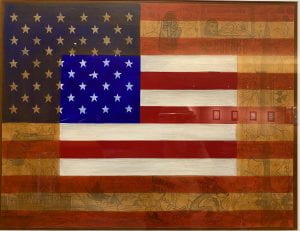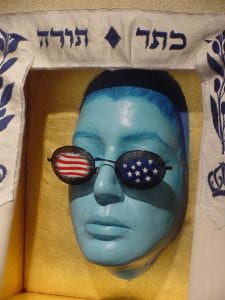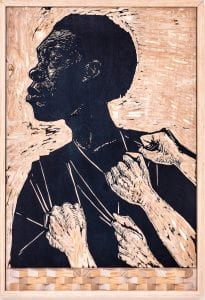Jenna Haines
Gallery:



Transcript
Siona Benjamin’s mixed media installation ‘My America’ is a personal piece that portrays the outlook Benjamin had of the United States as an Indian-Jewish woman preparing to immigrate to the US. The reflection of the American Flag in the sunglasses of the piece does not solely reflect what she is seeing. In the border of the flag the woman is looking at, there are pencil drawings of guns, nuclear weapons, and a resident alien card. As mentioned in the description of the installation, several of the drawings have a historical significance to WWII but they also have significant meaning to Siona Benjamin and the experiences she faced as an immigrant in the US. Together, both pieces of the “My America” installation reflects the theme of alienation. The word alienation is defined as, “the state or experience of being isolated from a group or an activity to which one should belong, or in which one should be involved.” The theme of alienation is depicted through the artist’s decision to purposely display the pieces far away from one another and seen in the drawings found on the American Flag portion of the installation. From my interpretation, Benjamin’s decision to intentionally separate the two pieces creates a clear separation between Siona and the United States. In the exhibit, the large distance between the two art pieces creates this feeling of an outsider looking in, creating this sense of alienation. I can imagine that several groups whether they are immigrants or those who have faced oppression and discrimiantion sometimes feel as if they are an outsider out the country they call home. Several of the drawings located in the border add to the theme of feeling alienated from society. Similar to the separation between the two pieces, Siona’s decision to include her resident alien card represents temporary residency but it also means having a connection to another place. As stated in the description, Benjamin purposely created this piece to show an inward and outward perspective after the fact that she had already given up her resident alien card to become a full US citizen. Even with the documentation that made her a full legal citizen of the US, Siona still felt this sense of isolation/division. Among the other images found on the flag there are drawings of guns, bullets, and nuclear weapons. While several of these symbols are tied to WWII, they can also represent how prevalent the idea of violence is throughout the United States and how that has impacted the idea of alienation. It is a well known fact that a country does not randomly come into existence, a country emerges and develops over time. This is the same with the US. Throughout our country’s history there have been a multitude of events that have impacted the structure and development of the United States, somewhat recent events such as 9/11 or the legalization of same sex marriage have caused several shifts in our country proving that nations are continuing to develop. However, with events such as 9/11 and the legalization of same sex marriage, negative stigma towards groups such as muslims and gay people increased. When analyzing the United States’ almost 250-year history, several groups have experienced a feeling of alienation due to the constant exclusion and inclusion of certain groups based upon factors such as ethnicity, religion, sexuality, gender, race, etc. While the US has created national amendments, groups to this day continue to be discriminated against causing people to feel alienated from society. Along with discrimnation against groups comes the possibility of hostile interactions involving weapons such as firearms. Look at the guns in the border of the American Flag, one gun pointed at someone else and the other one is pointed at you [the viewer]. This powerful imagery is meant to invoke an emotional response and portray how gun violence is something that immigrants and other groups who are discriminated against fear when it comes to living in America. Nobody should have to live their life thinking that one day their life might end just because of who they love, what they believe, or the color of their skin.
Another piece of art that relates to the “My America” installation is a carving made from wood block by the artist Jamaal Barber entitled, “To Be Free.” Personally, this piece reflects the repercussions that historical events have on the development/structure of a nation. Barber’s sculpture created in 2017, depicts a black man standing tall and looking off to the distance while he is simultaneously being pulled down by four Caucasian hands. The man in the carving shows no reaction to the arms trying to pull him downwards, his focus is on something out of the realm of the piece. Similar to the installation, both Barber’s and Benjamin’s pieces depict two people and their struggles with feeling betrayed or separated from a part of society. When asked about the wood carving, Jamaal Barber said, “There has been a system in place that negatively perceives blackness and acts to oppress people based on race. You must stand strong in yourself against the forces attempting to keep you down.” The “system” that Jamaal Barber refers to, is the same system of negative stigma created against black during African Slave Trade. From his writings about the African Diaspora, Albert J. Raboteau, a former scholar of African Religion, said, “In the New World slave control was based on the eradication of all forms of African Culture because of their power to unify the slaves and thus enable them to resist or rebel.” (4). Raboteau is saying that the goal of the slave trade in North America was to gain more control over the enslaved people by purposely separating families and members from the same tribe in order to eliminate all traces of African culture, thankfully the innocent people involved in the slave trade found ways to create new languages, songs, and traditions. However, while the “new” cultures/practices were being created and passed down by the slaves, negative stigma and opinions towards black people continued to spread. In the early to mid 1800s, Alexander Crummel, an African American minister born into a freed family, supported the idea of converting Liberians to Christianity. During the time of the Back to Africa Movement, the idea of “saving” the Africans through Christianty became a popular notion. Throughout the Crummel readings, the Liberian people were described with crude and negative words because of their differences in culture, skin color, and other factors. In one of his works about the creation of a Jewish Commonwealth, Rabbi Silver, a Zionsit leader and American Rabbi, discussed the overwhelmingly large support Anti-semites offered when it came to the creation of a Zionost state. The piece of Rabbi Silver’s work which I am referring to was published in 1943, a time where many Jewish people were seeking shelter in areas such as Europe and America. For Anti-semites to be offering tremendous support during the Jewish community’s time shows that the several members of the US and Europe did not want Jews in their country, even in their hour of need. Now, in 2022, 157 years after the abolition of slavery, 77 years after the end of WWII, and 58 years after the passing of the Civil Rights Act, discrimination against people based on religion, race, ethnicity, sexuality, etc. remains in the US. When it comes to Barber’s, and Benjamin’s pieces, they both depict a type of outlook that an oppressed person can have when it comes to living in America. Siona Benjmain’s piece shows a woman who feels like an outsider from society and accepts that America is a country ridden with violence and discrimnation Jamaal Barber’s piece shows a man who is constantly having to resist against the hands of the oppressors trying to bring him down. The theme of alienation is seen through both the installation and the carving because both of the people depicted are being impacted/seperated from society. Siona’s piece shows a woman who feels like an outsider even though she is legally a citizen and in the words of Jamaal Barber, “To be black in America is to constantly be working to overcome obstacles in the pursuit of freedom.” Barber’s carving depicts a man who has been wrongfully disadvantaged by society due to the discrimination that black people have faced since the times of slavery and now must reists the oppresors in order to survive and thrive in the US. Discrimination against groups will sadly remain in this country until the oppressors reflect on their harmful actions, until then, the groups who face oppression must remain steadfast and resilient against the threat of discrimination. A nation’s history will always have its impact and repercussion on society. The question is how do we react to the changes in society? Instead of being close-minded and violent, people need to embrace each other’s differences and accept that times have changed in order to stop people from feeling alienated from society.
Sources
“Alienation.” alienation noun – Definition, pictures, pronunciation and usage notes | Oxford Advanced Learner’s Dictionary at OxfordLearnersDictionaries.com. Accessed March 31, 2022. https://www.oxfordlearnersdictionaries.com/us/definition/english/alienation.
Raboteau, Albert J. “The African Diaspora.” Essay. In Slave Religion: The “Invisible Institution” in the Antebellum South, 4. Oxford University Press, 2004.
Sernett, Milton C. “Alexander Crummel ‘The Regeneration of America.’” Essay. In African American Religious History: A Documentary Witness, 30. Duke University Press, 1999.
“Seven Works of Art That Explore Race in America.” Atlanta Magazine, March 14, 2022. https://www.atlantamagazine.com/list/race-atlanta/seven-works-art-explore-race-america/.
Silver, Rabbi Abba H. “Toward American Jewish Unity (1943).” Essay. In Collection of Zionist Thinkers, 593, 1943.